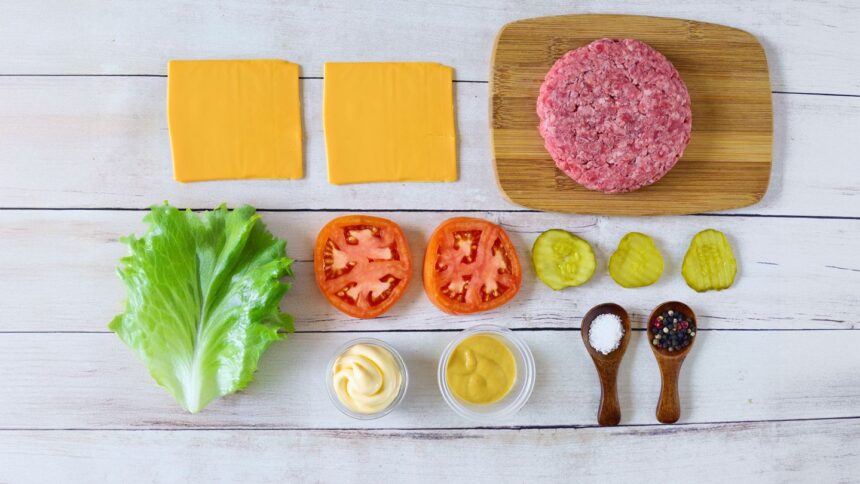If you’re looking to lose or maintain weight, the Atkins diet is one possible option for reaching your goals.
The Atkins diet menu restricts carbohydrates and emphasizes proteins and fats to aid weight loss. It’s similar to other keto diets.
By eliminating most carbs, the Atkins diet aims to help you burn fat for fuel rather than sugar. Meanwhile, proponents say its high-fat, high-protein menu and focus on vegetables may help you feel satiated and more energetic.
About the Atkins Diet Menu
The Atkins diet says the goal of the eating plan is to resolve many of the health problems associated with a diet high in refined carbohydrates, such as white sugar and flour, says Mayo Clinic.
The Atkins diet works in four phases:
- Phase 1 Induction
- Phase 2 Balancing
- Phase 3 Fine-tuning
- Phase 4 Maintenance
Phase 1 is the most restrictive phase. It’s when you eliminate almost all carbohydrates during the first two weeks of the diet. That means saying goodbye (for now) to most fruits, dairy, legumes, juices, whole grains, and starchy vegetables.
You don’t need to count calories or measure portions when using the Atkins meal plan, but you do need to count what it dubs as “net carbohydrates.”
To calculate net carbs, take the total carb content of a food and subtract its fiber content. For example, five spears of asparagus have 3.1 grams (g) of carbs and 1.68 g of fiber, making the net carbs 1.46 g, according to the U.S. Department of Agriculture (USDA).
During phase 1, you can have a total of 20 to 25 g of net carbs per day, according to the Atkins diet website. The bulk of this (12 to 15 g) should consist of vegetables, such as asparagus, broccoli, celery, cucumber, green beans, and peppers, says Mayo Clinic.
For cravings of bread or another grain, Atkins allows up to 3 g of net carbs per day (with restrictions), though the Atkins diet website says even this small amount of bread can slow weight loss progress.
Keep in mind that “net carbs” is not a legal term that the U.S. Food and Drug Administration (FDA) or other organizations use when evaluating a food’s nutritional value.
The American Diabetes Association (ADA) says this calculation isn’t accurate, and both the ADA and the FDA say it’s better to consider the total amount of carbs rather than the net carbs.
Atkins Diet Potential Health Benefits and Risks
In comparison to a diet that restricts fat, some evidence suggests ketogenic diets, like Atkins, may show promise as treatments for diabetes and obesity, according to an article in The Journal of Nutrition.
Research suggests they may support healthy blood glucose and insulin levels and may help with diseases linked with insulin resistance, such as cancer and neurodegenerative conditions.
However, the article author notes more research is needed to understand the long-term effects of the diet.
There are also risks to consider before starting Atkins or other low-carb diets. Mayo Clinic says drastically reducing carbs in phase 1 may result in headaches, dizziness, weakness, fatigue, or constipation, as well as nutritional deficiencies.
Your body may also enter a state of ketosis. This is when your body breaks down fat instead of carbs for fuel. Side effects of ketosis include nausea, headaches, mental fatigue, and bad breath.
Check with your doctor before starting the Atkins diet, especially if you take diuretics, insulin, or oral diabetes medications, says Mayo Clinic. Do not follow this diet if you have kidney disease, are pregnant, or are breastfeeding.
If you get the go-ahead from your healthcare provider to try the Atkins diet, start with some of the Atkins meal plan suggestions below. Atkins diet recipes can be healthy and tasty, and after phase 1, you might find you no longer crave carbs, especially highly processed sugars and flours.
Phase 1 Example Meals
It’s helpful to familiarize yourself with the Atkins diet’s list of phase 1 acceptable foods before you get started.
Don’t starve yourself. Aim to eat every three to four hours throughout the day. Drink plenty of water, too — Mayo Clinic recommends at least eight glasses a day.
After induction, you’ll gradually start adding carbs back into your diet. For now, focus on learning the carb content of foods, reading nutrition labels for net carb content, and experimenting with different Atkins diet recipes of your own.
Below are a few ideas for Atkins diet recipes and foods to try in phase 1. For your meats, avoid processed meat, including bacon and ham that have been cured with sugar, and cold cuts and other meats with nitrates and other preservatives.
Meal 1: Breakfast
- Spinach and cheese omelet topped with salsa and sliced avocado
- Lean strips of steak sautéed with allowed vegetables, such as sliced onion and bell peppers
- Smoked salmon with cream cheese and cucumber
- Two eggs with bacon and 1/2 cup of allowed vegetables
- Loaded veggie omelet cooked with allowed vegetables
Meal 2: Lunch
- Salad with mixed greens topped with diced raw vegetables and grilled chicken
- Tuna salad spooned into fresh avocado halves
- Atkins-brand frozen entrée, such as Italian sausage primavera
- Chicken or turkey meatballs served over spaghetti squash
- Lean beef stir-fry with broccoli, bok choy, and onion
Meal 3: Dinner
- Grilled fish served with steamed vegetables and a salad
- Ground beef burger with a lettuce “bun” and 1/2 cup of allowed vegetables
- Broiled pork chop with mashed cooked cauliflower mixed with cheese
- Grilled chicken and veggie kabobs
- Ground turkey taco salad with allowed veggies and 1 ounce shredded cheddar cheese
Eat one or two snacks between meals, and pair any higher-carb foods with a source of protein or fat. Examples of pairings include raw celery sticks with low-carb salad dressing, cherry tomatoes with your favorite allowed cheese, and cucumber slices with cream cheese.
Remember to track your net carbs throughout the day so you stay within the limit.
Finally, season your meals with salt, pepper, herbs, or spices, but avoid condiments with a high-carb content, such as ketchup or salad dressing containing added sugars.
In addition to water, you can drink coffee, tea, plant-based milk, and diet soda (in moderation). Again, check your net carbs before adding anything to your cup of coffee or tea, as some creamers contain added sugar.






![Pull Apart Christmas Tree [Vegan] – One Green Planet](https://top-100-recipes.com/wp-content/uploads/2025/12/xscreen-shot-2019-11-29-at-1-57-39-pm-150x150.png.pagespeed.ic.9pB2mNa6N_.jpg)


